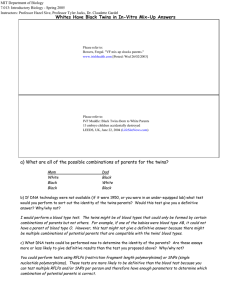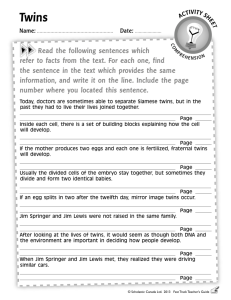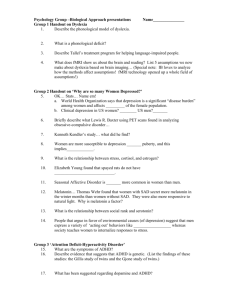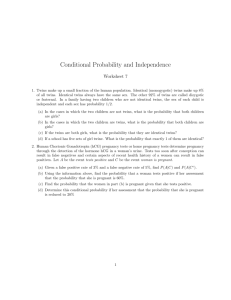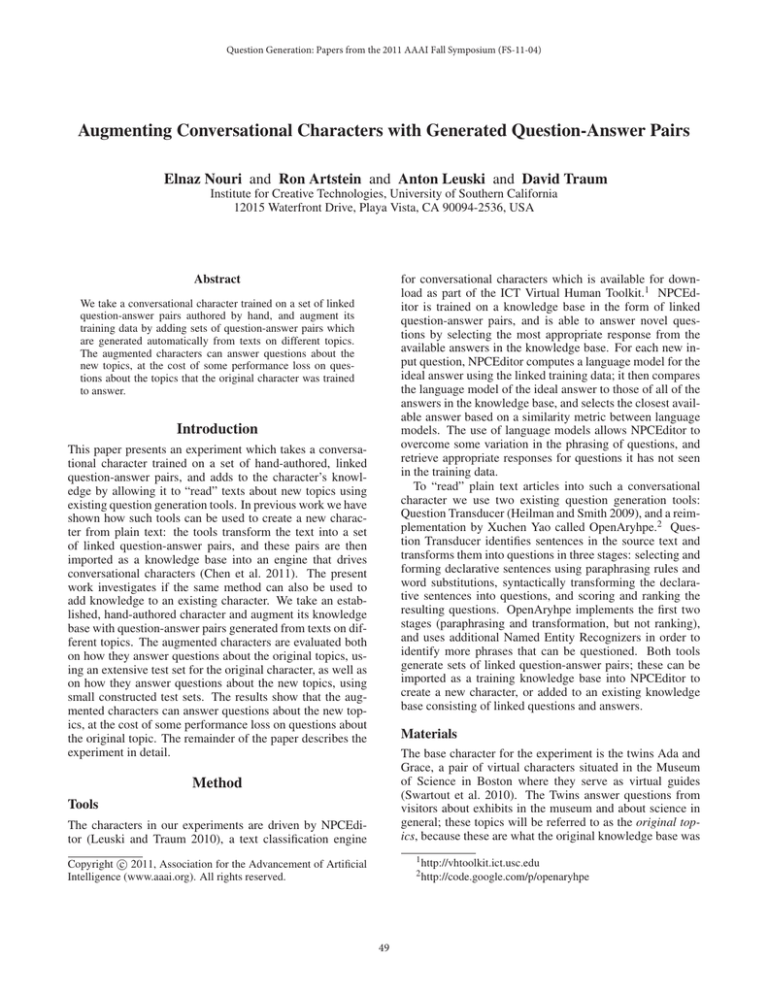
Question Generation: Papers from the 2011 AAAI Fall Symposium (FS-11-04)
Augmenting Conversational Characters with Generated Question-Answer Pairs
Elnaz Nouri and Ron Artstein and Anton Leuski and David Traum
Institute for Creative Technologies, University of Southern California
12015 Waterfront Drive, Playa Vista, CA 90094-2536, USA
for conversational characters which is available for download as part of the ICT Virtual Human Toolkit.1 NPCEditor is trained on a knowledge base in the form of linked
question-answer pairs, and is able to answer novel questions by selecting the most appropriate response from the
available answers in the knowledge base. For each new input question, NPCEditor computes a language model for the
ideal answer using the linked training data; it then compares
the language model of the ideal answer to those of all of the
answers in the knowledge base, and selects the closest available answer based on a similarity metric between language
models. The use of language models allows NPCEditor to
overcome some variation in the phrasing of questions, and
retrieve appropriate responses for questions it has not seen
in the training data.
To “read” plain text articles into such a conversational
character we use two existing question generation tools:
Question Transducer (Heilman and Smith 2009), and a reimplementation by Xuchen Yao called OpenAryhpe.2 Question Transducer identifies sentences in the source text and
transforms them into questions in three stages: selecting and
forming declarative sentences using paraphrasing rules and
word substitutions, syntactically transforming the declarative sentences into questions, and scoring and ranking the
resulting questions. OpenAryhpe implements the first two
stages (paraphrasing and transformation, but not ranking),
and uses additional Named Entity Recognizers in order to
identify more phrases that can be questioned. Both tools
generate sets of linked question-answer pairs; these can be
imported as a training knowledge base into NPCEditor to
create a new character, or added to an existing knowledge
base consisting of linked questions and answers.
Abstract
We take a conversational character trained on a set of linked
question-answer pairs authored by hand, and augment its
training data by adding sets of question-answer pairs which
are generated automatically from texts on different topics.
The augmented characters can answer questions about the
new topics, at the cost of some performance loss on questions about the topics that the original character was trained
to answer.
Introduction
This paper presents an experiment which takes a conversational character trained on a set of hand-authored, linked
question-answer pairs, and adds to the character’s knowledge by allowing it to “read” texts about new topics using
existing question generation tools. In previous work we have
shown how such tools can be used to create a new character from plain text: the tools transform the text into a set
of linked question-answer pairs, and these pairs are then
imported as a knowledge base into an engine that drives
conversational characters (Chen et al. 2011). The present
work investigates if the same method can also be used to
add knowledge to an existing character. We take an established, hand-authored character and augment its knowledge
base with question-answer pairs generated from texts on different topics. The augmented characters are evaluated both
on how they answer questions about the original topics, using an extensive test set for the original character, as well as
on how they answer questions about the new topics, using
small constructed test sets. The results show that the augmented characters can answer questions about the new topics, at the cost of some performance loss on questions about
the original topic. The remainder of the paper describes the
experiment in detail.
Materials
The base character for the experiment is the twins Ada and
Grace, a pair of virtual characters situated in the Museum
of Science in Boston where they serve as virtual guides
(Swartout et al. 2010). The Twins answer questions from
visitors about exhibits in the museum and about science in
general; these topics will be referred to as the original topics, because these are what the original knowledge base was
Method
Tools
The characters in our experiments are driven by NPCEditor (Leuski and Traum 2010), a text classification engine
1 http://vhtoolkit.ict.usc.edu
c 2011, Association for the Advancement of Artificial
Copyright Intelligence (www.aaai.org). All rights reserved.
2 http://code.google.com/p/openaryhpe
49
Length
(words)
Source Article
Australia
Beer
Ludvig van Beethoven
a OpenAryhpe
567
299
765
Extracted Q-A Pairs
Character
OAa
QTb
Tot.c
240
146
338
308
231
635
500
315
889
Twins
Twins + Australia
Twins + Beer
Twins + Beethoven
Twins + Australia + Beer
Twins + Aus. + Beer + Beeth.
b Question
Transducer c The total is less
than the sum of OA and QT due to overlap.
Questions Answers Q-A Pairs
406
652
559
849
804
1245
148
342
268
421
462
735
483
999
807
1412
1323
2252
Table 2: Training data for the various characters
Table 1: Wikipedia text excerpts and question-answer pairs
different testing runs – all characters are tested on exactly
the same utterance texts. From the point of view of a classifier for the original topics, question-answer pairs from the
new topics can be considered as training noise; what the different characters test, then, is how the addition of knowledge
bases for new topics affects the performance of the original,
hand-authored part of the character.
The test set consists of 7690 utterances. These utterances
were collected on 56 individual days so they represent several hundred visitors; the majority of the utterances (almost
6000) come from two handlers. Each utterance contains the
original speech recognizer output retrieved from the system
logs (speech recognition was performed using the SONIC
toolkit, Pellom and Hacıoğlu 2001/2005). Some of the utterances are identical – there is a total of 2264 utterance
types (speech recognizer output), corresponding to 265 transcribed utterance types (transcriptions were performed manually). The median word error rate for the utterances is
20% (mean 29%, standard deviation 36%). This level of
word error rate is acceptable for this application – as we
will see below, the original character fails to understand
only 10% of the input utterances, and this error rate declines rapidly when the character is allowed to identify its
own non-understanding (Figure 1).
designed for. All the training data for the Twins were authored by hand.
The base character is successively augmented by adding
question-answer pairs generated automatically according to
the method described in Chen et al. (2011):
1. Text excerpts are manually selected from articles in Simple English Wikipedia.3 We started with a sample of
14 texts which were prepared for a pilot experiment, and
arbitrarily chose three of the texts for the present experiment (Table 1). These will be referred to as the new topics.
2. The texts are transformed into question-answer pairs using the two question generation tools mentioned above,
Question Transducer and OpenAryhpe.
3. The question-answer pairs from both question generation tools are imported into NPCEditor and added to the
Twins’ training data.
We trained a total of five augmented characters in addition
to the baseline; Table 2 shows the number of questions, answers and links in each of the sets of training data.
Test set
Original topics. To test performance of the augmented
characters on questions from the Twins’ original topics we
use an extensive test set collected during the initial stages
of the Twins’ deployment at the Museum of Science, when
visitor interaction was done primarily through trained handlers (relying on handlers allowed us to deploy the characters prior to collecting the required amount of visitor speech,
mostly from children, necessary to train acoustic models for
speech recognition). The handlers relay the visitors’ questions through a microphone to be processed by a speech recognizer; they also tend to reformulate user questions to better match the questions in the Twins’ knowledge base, and
many of their utterances are a precise word for word match
of utterances in the Twins’ training data. Such utterances are
a good test case for the classifier because the intended correct responses are known, but actual performance varies due
to speech recognition errors; they thus test the ability of the
classifier to overcome variation in the phrasing of questions.
The same test set was used in Wang et al. (2011) to compare various methods of handling speech recognizer output;
here we use it to compare different character knowledge
bases. The speech recognizer output remains constant in the
New topics. We also test performance of the augmented
characters on questions relating to the new topics. Since we
do not have an extensive set of spoken utterances as for the
Twins’ original topics, we use a small, manually authored
test set that was developed in a pilot experiment for Chen et
al. (2011). The test set includes, for each topic, a small set
of questions, with associated answers that are taken from the
source text.
Evaluation
Original topics. To evaluate performance on questions
from the original topics, we run our test set through each
of the characters in Table 2. For each utterance we send the
text of the speech recognizer output to NPCEditor, and compare the response to the answers linked to the corresponding
manual transcription. A response is scored as correct if it
matches one of the linked answers, otherwise it is scored
as incorrect. We also collect the confidence scores reported
by NPCEditor in order to enable the analysis in Figure 1
below (the confidence score is the inverse of the KullbackLeibler divergence between the language models of the ideal
response and the actual response; see Leuski and Traum
2010).
3 http://simple.wikipedia.org
50
Test Set
Character
Australia Beer Beethoven
N=
Figure 1: Trade-off between errors and non-returns
9
10
14
Stand-alone (without Twins)
5
8
10
Twins + Australia
Twins + Beer
Twins + Beethoven
Twins + Australia + Beer
Twins + Aus. + Beer + Beeth.
Twins
5
7
9
5
5
0
7
6
0
9
0
Table 3: Correct responses from the augmented characters
New topics. Performance on questions relating to the
added knowledge bases is evaluated manually. The text
of each question is sent to NPCEditor, and the response is
marked as correct, partly correct, or incorrect after comparing it to the predetermined answer key. All the manual ratings were performed by the first author.
corresponding error rates on the vertical axis; at the extreme
right, where no responses are returned, error rates are necessarily zero for all characters. Lower curves indicate better
performance.
The best performer on the test set for the original topics is the original Twins character, with a 10% error rate
when all responses are returned, and virtually no errors with
a non-return rate above 20%. Performance degrades somewhat with the successive addition of automatically generated questions from the new topics, though the degradation
is mitigated to some extent when higher non-return rates are
acceptable. In exchange for an increased error rate on questions from the original topics, the augmented characters can
now answer questions pertaining to the new topics.
Results
Performance on the original topics
Just counting the correct and incorrect responses is not sufficient for evaluating character performance, because NPCEditor employs dialogue management logic designed to avoid
the worst outputs. During training, NPCEditor calculates a
response threshold based on the classifier’s confidence in the
appropriateness of selected responses: this threshold finds
an optimal balance between false positives (inappropriate
responses above threshold) and false negatives (appropriate
responses below threshold) on the training data. At runtime, if the confidence for a selected response falls below
the predetermined threshold, that response is replaced with
an “off-topic” utterance that asks the user to repeat the question or takes initiative and changes the topic (Leuski et al.
2006); such failure to return a response (also called nonunderstanding, Bohus and Rudnicky 2005) is usually preferred over returning an inappropriate one (misunderstanding).
The capability to not return a response is crucial in keeping conversational characters coherent, but it is not captured
by standard classifier evaluation methods such as accuracy,
recall (proportion of correct responses that were retrieved),
or precision (proportion of retrieved responses that are correct). We cannot use the default threshold calculated by
NPCEditor during training, because these default thresholds
yield different return rates for different characters. We therefore use a graphical evaluation method which looks at the
full trade-off between return levels and error rates (Artstein
2011).
For each test utterance we logged the top-ranked response
together with its confidence score, and then we plotted the
rate of off-topics against errors at each possible threshold;
this was done separately for each character (since confidence
scores are based on parameters learned during training, they
are not comparable across characters). Figure 1 shows the
curves for the baseline character and the 5 augmented characters: non-returns are plotted on the horizontal axis and
Performance on the new topics
Each new topic has a small set of manually constructed test
questions. We first ran each test set through a stand-alone
character generated automatically using only the questionanswer pairs extracted from the corresponding source text.
This represents the ceiling we can expect for performance
of the augmented characters. Performance is not perfect, but
for each topic the character gives a correct or partly correct
answer more than half of the time (Table 3).
Performance of the augmented characters is only slightly
degraded compared to that of the stand-alone characters. We
tested each question set on those characters that included the
relevant knowledge base. The number of correct or partially
correct responses is shown in Table 3, and in each case, the
correct responses are a subset of the correct responses returned by the corresponding stand-alone character. We also
tested the question sets on the original Twins character – as
expected, none of the returned responses is a correct answer.
Conclusion
Our experiment demonstrates that automatic question generation is a viable way to add knowledge from sources in
plain text to a hand-authored question answering conversational character. Adding such knowledge does affect the
character’s performance, increasing the error rate on questions from the original topics that the character was designed
to answer. In return, however, the augmented character can
51
also answer questions about the new topics that are covered
in the textual sources.
Report CMU-LTI-09-013, Carnegie Mellon University Language Technologies Institute.
Leuski, A., and Traum, D. 2010. Practical language processing for virtual humans. In Twenty-Second Annual Conference on Innovative Applications of Artificial Intelligence
(IAAI-10).
Leuski, A.; Patel, R.; Traum, D.; and Kennedy, B. 2006.
Building effective question answering characters. In Proceedings of the 7th SIGdial Workshop on Discourse and Dialogue.
Pellom, B., and Hacıoğlu, K. 2001/2005. SONIC: The University of Colorado continuous speech recognizer. Technical
Report TR-CSLR-2001-01, University of Colorado, Boulder.
Swartout, W.; Traum, D.; Artstein, R.; Noren, D.; Debevec,
P.; Bronnenkant, K.; Williams, J.; Leuski, A.; Narayanan,
S.; Piepol, D.; Lane, C.; Morie, J.; Aggarwal, P.; Liewer,
M.; Chiang, J.-Y.; Gerten, J.; Chu, S.; and White, K. 2010.
Ada and Grace: Toward realistic and engaging virtual museum guides. In Allbeck, J.; Badler, N.; Bickmore, T.; and
Pelachaud, Catherine Safonova, A., eds., Intelligent Virtual
Agents: 10th International Conference, IVA 2010, Philadelphia, PA, USA, September 20–22, 2010 Proceedings, volume 6356 of Lecture Notes in Artificial Intelligence, 286–
300. Heidelberg: Springer.
Wang, W. Y.; Artstein, R.; Leuski, A.; and Traum, D. 2011.
Improving spoken dialogue understanding using phonetic
mixture models. In Proceedings of the Twenty-Fourth International Florida Artificial Intelligence Research Society
Conference, 329–334. Palm Beach, Florida: AAAI Press.
Acknowledgments
Thanks to Michael Heilman and Xuchen Yao, the respective
authors of Question Transducer and OpenAryhpe, for giving us access to their code and allowing us to use it in our
experiments.
The project or effort described here has been sponsored
by the U.S. Army Research, Development, and Engineering Command (RDECOM). Statements and opinions expressed do not necessarily reflect the position or the policy
of the United States Government, and no official endorsement should be inferred.
References
Artstein, R. 2011. Error return plots. In Proceedings of
the SIGDIAL 2011 Conference, 319–324. Portland, Oregon:
Association for Computational Linguistics.
Bohus, D., and Rudnicky, A. I. 2005. Sorry, I didn’t catch
that! – An investigation of non-understanding errors and recovery strategies. In Proceedings of the 6th SIGdial Workshop on Discourse and Dialogue, 128–143.
Chen, G.; Tosch, E.; Artstein, R.; Leuski, A.; and Traum, D.
2011. Evaluating conversational characters created through
question generation. In Proceedings of the Twenty-Fourth
International Florida Artificial Intelligence Research Society Conference, 343–344. Palm Beach, Florida: AAAI
Press.
Heilman, M., and Smith, N. A. 2009. Question generation
via overgenerating transformations and ranking. Technical
52



